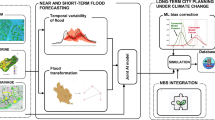Abstract
Optimization of land use structure consists of economic and social and ecological optimization. Applying the minds of system engineering and principles of ecology, this paper presents such thoughts: the optimal forest-coverage rate calculated according to the reality of a district is set as main standard of ecological rationality in the district; through considering the value of ecosystem services of the land with GREEN equivalent (mainly cultivated land and grassland) and based on the rule, GREEN equivalent, this paper introduces the area conversion between woodland and cultivated land, also between woodland and grassland; this paper establishes a multi-dimension controlling model of optimization of land use structure. In addition, a multi-objective linear programming model for optimization of land use structure is designed. In the end, this paper tests and verifies this theory of ecological optimization, taking Qionghai city in Hainan Province as an example.
Similar content being viewed by others
References
Wang W M (1996) Theory of land use planning. Beijing: China Land Press. (in Chinese)
Mao W Y (1998) Generality of environment impact assessment. Beijing: China Environmental Science Press. (in Chinese)
Li J C (1996) Theory of ecological value. Chongqing: Chongqing University Press. (in Chinese)
Zhang J, Gong Y B, Chen L W (1996) A quantitative discussion on forest of the optimum rorest protective effect.Scientia Silvae Sinicae. (in Chinese)
Lu X S (2000) Report on land and resources of China in 1999. Beijing: Ocean Press. (in Chinese)
Lei X Z, Wang J X, Peng P H (1999) The benefit evaluation index of ecological forest engineering of China.Journal of Natural Resources. (in Chinese)
Liu Y F (1992) Economic geography. Wuhan: Publishing House of Central China Normal University. (in Chinese)
Zhang G X, Huang L Y, Liu Y S (2000) Regional optimizing model of land utilizing structure and the elasticity problems of coastal plantation homeostasis with Yueqing city in zhejiang province as an example,Journal of Shanxi Teacher's University (Natural Science Edition). (in Chinese)
Geng H, Wang Z M (1999) Research on optimization of land use structure based on gray linear programming.Journal of Wuhan Technical University of Surveying and Mapping, 25(2):167–171 (in Chinese)
Xue J Q (1989) Llinear programming. Beijing: High Education Press (in Chinese)
Xue Z R, Ma D M, Duan Y Q, et al. (1993) Research on city ecological planning. Beijing: Weather Press. (in Chinese)
Author information
Authors and Affiliations
Corresponding author
Additional information
Project supported by the Open Fund of National Laboratory for Information Engineering in Surveying, Mapping and Remote Sensing(990301).
About this article
Cite this article
Yanfang, L., Dongping, M. & Jianyu, Y. Optimization of land use structure based on ecological GREEN equivalent. Geo-spat. Inf. Sci. 5, 60–67 (2002). https://doi.org/10.1007/BF02826478
Issue Date:
DOI: https://doi.org/10.1007/BF02826478




